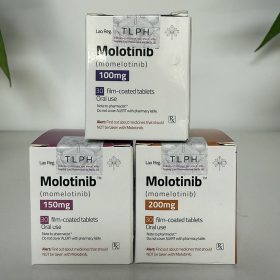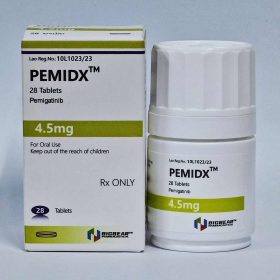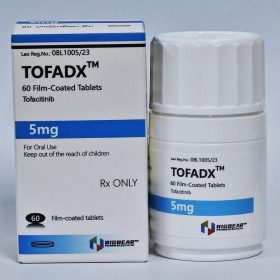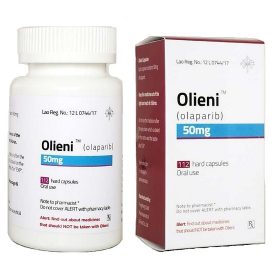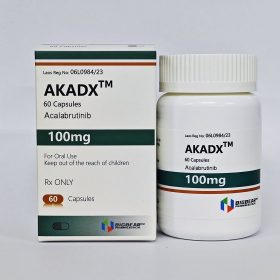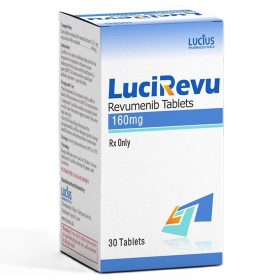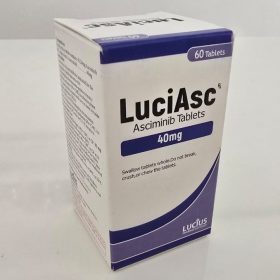- Details
- Description
-
Packaging Size60t/Bottle/Box
-
Strength70mg
-
CompositonDasatinib
-
TreatmentPh+ Chronic myelogenous leukemia (CML) and acute lymphoblastic leukemia (ALL)
-
FormTablet
-
BrandLuciDasa
-
Quantity Unit70mg*60t/Box
-
ManufacturerLucius Pharmaceuticals (Lao) Co.,Ltd
About Dasatinib
Dasatinib is a targeted therapy medication used to treat certain cases of chronic myelogenous leukemia (CML) and acute lymphoblastic leukemia (ALL). Specifically it is used to treat cases that are Philadelphia chromosome-positive (Ph+).
Acute Lymphoblastic Leukemia (ALL)
Indicated for treatment of Philadelphia chromosome-positive (Ph+) ALL in adults with resistance or intolerance to prior therapy
Initial, 140 mg PO daily; may increase to 180 mg PO daily if hematologic or cytogenetic response not achieved with initial dosage
Chronic Myeloid Leukemia (CML)
Newly diagnosed CML in chronic phase
- 100 mg PO daily; may increase to 140 mg PO daily if hematologic or cytogenetic response not achieved with initial dosage
- Therapy was continued until disease progression or until no longer tolerated in clinical studies
Previously treated CML
- Indicated for treatment of chronic, accelerated, or myeloid or lymphoid blast phase Ph+ CML in adults with resistance or intolerance to prior therapy including imatinib
- Initial, 140 mg PO daily; may increase to 180 mg PO daily if hematologic or cytogenetic response not achieved with initial dosage
Acute Lymphoblastic Leukemia (ALL)
Indicated for treatment of Philadelphia chromosome-positive (Ph+) ALL in adults with resistance or intolerance to prior therapy
Initial, 140 mg PO daily; may increase to 180 mg PO daily if hematologic or cytogenetic response not achieved with initial dosage
Chronic Myeloid Leukemia (CML)
Newly diagnosed CML in chronic phase
- 100 mg PO daily; may increase to 140 mg PO daily if hematologic or cytogenetic response not achieved with initial dosage
- Therapy was continued until disease progression or until no longer tolerated in clinical studies
Previously treated CML
- Indicated for treatment of chronic, accelerated, or myeloid or lymphoid blast phase Ph+ CML in adults with resistance or intolerance to prior therapy including imatinib
- Initial, 140 mg PO daily; may increase to 180 mg PO daily if hematologic or cytogenetic response not achieved with initial dosage
Dosage Modifications
Myelosuppression
-
Chronic phase CML (100 mg/day starting dose)
- ANC <0.5 x 10^9/L or platelets <50 x 10^9/L: Hold until ANC ≥1 x 10^9/L and platelets ≥50 x 10^9/L; resume at original starting dose if recovery occurs in ≤7 days
- Platelets <25 x 10^9/L or recurrence of ANC <0.5 x 10^9/L for >7 days: Hold until ANC ≥1 x 10^9/L and platelets ≥50 x 10^9/L; resume at reduced dosage of 80 mg PO daily for second episode and 50 mg PO daily (newly diagnosed CML) or discontinue (previously treated CML) for third episode
-
Ph+ ALL and accelerated or blast phase CML (140 mg/day starting dose)
- Perform bone marrow assessment to determine if cytopenia is related to leukemia
- Hold until ANC ≥1 x 10^9/L and platelets ≥20 x 10^9/L and resume at original starting dose if cytopenia is unrelated to leukemia
- If cytopenia recurs, repeat bone marrow assessment and resume at reduced dose of 100 mg PO daily for second episode or 80 mg PO daily for third episode
- If cytopenia is related to leukemia, consider dose escalation to 180 mg PO daily
Non-hematologic toxicity
-
Severe toxicity
- Hold until toxicity has resolved or improved
- Resume as appropriate at reduced dose depending on severity and recurrence
Renal impairment
- CrCl 21.6-342.3 mL/min: No significant impact on pharmacokinetics
Hepatic impairment
- Mild (Child Pugh A): No data
- Moderate (Child Pugh B): No dosage adjustment guidance provided by manufacturer; exposure decreased by 8% compared with normal liver function
- Severe (Child Pugh C): No dosage adjustment guidance provided by manufacturer; exposure decreased by 28% compared with normal liver function
Strong CYP3A4 inducers
- Avoid coadministration
- If coadministration of strong CYP3A4 inducer is unavoidable, consider increasing dasatinib dose and monitor for toxicity
Strong CYP3A4 inhibitors
- Avoid coadministration and select alternate concomitant medication with no or minimal enzyme inhibition potential, if possible
-
Dosage adjustment for use with strong CYP3A4 inhibitor if coadministration cannot be avoided
- Current dose 140 mg/day: Decrease to 40 mg PO daily
- Current dose 100 mg/day or 70 mg/day: Decrease to 20 mg PO daily
- Current dose 60 or 40 mg/day: Consider holding therapy until inhibitor is discontinued
- If dasatinib is not tolerated after dose reduction, either discontinue strong CYP3A4 inhibitor or interrupt dasatinib until inhibitor is discontinued
- Allow a washout period of ∼1 week after inhibitor is stopped before reinitiating or increasing dasatinib dose



